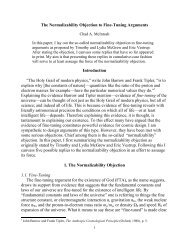Theism and Explanation - Appeared-to-Blogly
Theism and Explanation - Appeared-to-Blogly
Theism and Explanation - Appeared-to-Blogly
Create successful ePaper yourself
Turn your PDF publications into a flip-book with our unique Google optimized e-Paper software.
Notes 183<br />
it will also confi rm H 2 . So my observing a yellow cup (which is a non-black,<br />
non-raven) apparently confi rms the hypothesis that all ravens are black.<br />
17. Worrall, “Methodology,” 48.<br />
18. Musgrave, “Evidential Support,” 185–86.<br />
19. Ibid., 197 n. 17.<br />
20. Musgrave, Essays on Realism, 232–33; Sober, Reconstructing the Past, §2.5<br />
[61–63]).<br />
21. Musgrave, Essays on Realism, 244.<br />
22. Swinburne, Existence of God, 160–66.<br />
23. Sober, “Testability,” 70.<br />
24. Musgrave, Essays on Realism, 246.<br />
25. Ibid.<br />
26. This seems <strong>to</strong> be what Paul Thagard (“The Best <strong>Explanation</strong>,”181) means by<br />
“dynamic consilience”; it is a view that fi nds more detailed expression in the<br />
work of Imre Laka<strong>to</strong>s (“Falsifi cation,” 134).<br />
27. Peter Lip<strong>to</strong>n’s remarks (Inference <strong>to</strong> the Best <strong>Explanation</strong>, 95–97, 101) may<br />
offer a way ahead.<br />
28. Timmer, “Scientists on Science,” section on “Explana<strong>to</strong>ry Power.”<br />
29. Sober, “Testability,” 58, “Intelligent Design,” 67, “Design Argument,” 34.<br />
30. Both examples are Sober’s (“Design Argument,” 34).<br />
31. Sober, “Design Argument,” 34.<br />
32. Sober, “Testability,” 70.<br />
33. As I noted earlier (2.1.4), one could still employ probability calculations<br />
<strong>to</strong> decide on the posterior probability of the hypothesis in question—<br />
Pr(H|E&K)—even if the likelihood of the evidence, given the hypothesis—<br />
Pr(E|H)—is 1.0. In other words, one could employ confi rmation theory<br />
in order <strong>to</strong> assess the degree of evidential support that a proposed theistic<br />
explanation enjoys, even if that explanation is deductive in form. But this<br />
does not appear <strong>to</strong> be how Swinburne is arguing.<br />
34. Draper, “Pain <strong>and</strong> Pleasure,” 332.<br />
35. To put it this way assumes that “it happened by chance” represents an explanation.<br />
Does it? I don’t know; for a discussion, see Psillos, Causation <strong>and</strong><br />
<strong>Explanation</strong>, 9.4 (256–59) <strong>and</strong> 11.2 (285–87). In any case, my point is that<br />
we can always test a theistic hypothesis over against the assumption that the<br />
event in question happened by chance.<br />
36. Hales, “Evidence <strong>and</strong> the Afterlife,” 341–42, citing an anonymous internet<br />
article.<br />
37. Wilcox, “Dark Sucker Theory.”<br />
38. As Wilcox suggests (ibid., Question 12), DST also makes no predictions<br />
that would allow one <strong>to</strong> discriminate between it <strong>and</strong> our accepted theories<br />
of light (7.1).<br />
39. Another real-life example, highlighted by Paul Thagard (“The Best <strong>Explanation</strong>,”<br />
186), is the way in which the analogies between sound <strong>and</strong> light supported<br />
the wave theory of light.<br />
40. Depew <strong>and</strong> Weber, Darwinism Evolving, 71.<br />
41. Darwin, Origin of Species, Chap. 4 (132–33).<br />
42. Depew <strong>and</strong> Weber, Darwinism Evolving, 148–49.<br />
43. Thagard, “The Best <strong>Explanation</strong>,”188.<br />
44. Hempel, Philosophy of Natural Science, 83–84.<br />
45. Thagard, “The Best <strong>Explanation</strong>,” 188.<br />
46. Quine <strong>and</strong> Ullian, Web of Belief, 67.<br />
47. Mackie, Miracle of <strong>Theism</strong>, 100.<br />
48. Ibid.<br />
49. Swinburne, “Mackie, Induction, <strong>and</strong> God,” 387.



